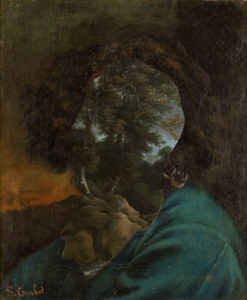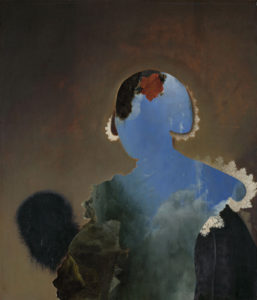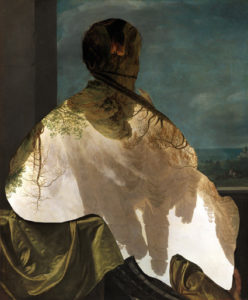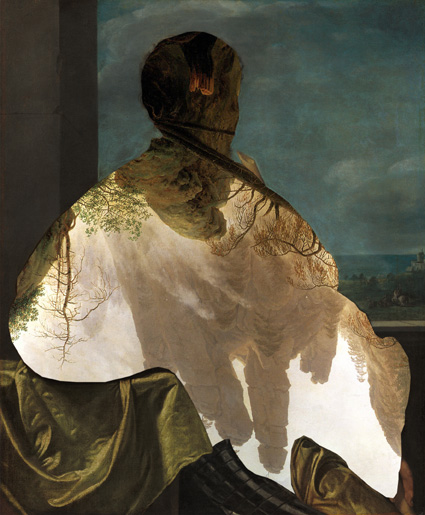In other words, contemporaneity is a singular relationship with one’s own times, one that both participates in them and also distances itself from them. To be more exact, it is that relationship with time that participates in it through a displacement and an anachronism. (Giorgio Agamben)
Harmony is the first word that comes to mind when looking at the works by Alessandro Gioiello, the harmony of epochs that meet, the harmony that art is able to create and that sovereign time reunites. It is a harmony of proportions, spaces, and landscapes, bonds of beauty and delicacy; it is the creation of a different aesthetic that rediscovers its origin in the purity of universality. In a famous poem, Sappho makes sweet use of the term Kálliston in order to define beauty, a fundamental concept in the poetics of Alessandro Gioiello who gives life to his works by interweaving such modern images as Lorenzo Lotto’s Ritratto di giovane con lucerna with the landscape by Johann Christoph Dietzsch, La Velata by Raphael with First Snow by D.C. Friedrich, or Velazquez’s Portrait of Juan de Pareja with View of the Waterfalls at Tivoli by J.J. Xavier Bidauld. This is the art of Alessandro Gioiello, a visionary and dreamlike art that remains eternal in its most up-to-date expression of contemporaneity, that of collage.
These works, created from labyrinthine games, fragmented delicacy, chimerical complexity, lead us to an idea of illusory landscape which gives rise to a representation of spatiality, the reformulation of a varied and kaleidoscopic dialectic which traverses the concept, not only of aesthetics, but also of eternity, describing it with the lightness of poetry and the creativity of a story figured out after just a brief glance. Alessandro Gioiello illustrates landscapes that encapsulate innate poetics, the essence and only aim of which is to lead us to think about contemporaneity in art, its existence, the identity of Mnemosýne the muse of memory, and about its link to inspiration by referring us to Merleau-Ponty’s considerable ideas. Intuitions that we rediscover in the scenarios devised by the artist who leads us towards that aspect of the infinite and the sublime that he, and above all his art, cannot go beyond.
Gioiello presents us with an archetypical poetics of a dialogue in which time, his real leitmotif, leads our mind to lose itself among the deceptive paths along which his presence echoes in the temporal annulment between existence and essence, and by which the artist affirms the eternity of the work, that eternity possessed by his art and through which he attempts to disorientate us. In one of his most famous phrases, Egon Schiele stated that “Art cannot be modern; Art belongs to eternity”, and it is this eternity that Alessandro Gioiello describes by recounting his personal vision of time and art. And it is the melancholy narration of the series of ethereal slides that rapidly creates the configuration of collages projected onto the walls, inspired by the poetics of Marcel Broodthaers; in them we glimpse Clio the muse of time and history, and near to the bottom of the horizon we perceive her calling to the other two muses, Mnemosýne and Harmony, and it is here that they come together to create immensity. Gioiello, with this deliberate sweetness, this one-to-one story of landscapes, which he can send us to with his art, develops scenarios which we can enter in search of ourselves within a work that annuls our being.
His art is the research undertaken by a casual glance, an inquiry into an intuition that our wandering mind continues to yearn for. Thanks to his inventiveness, the artist transfigures and reinterprets, thus creating a new flowering of forms; he rereads space by reliving the phenomenological experience of the concept of spatiality and subjectivity; he does so in order to rethink images within the perspective of time and to place them in another place, a non-place, that only free thought and inspiration can create.
And so there are created collages that have the irreverence and the audacity of contemporaneity together with the silence of modernity. Visual traps invented by the dialogue between two deceptive, surreal situations. Gioiello creates a continuity between two symbiotic profiles in search of a third: a new image, a new artistic idiom. This language of his destabilises us all, starting from our point of view which is placed in front of an apparent narrative of superimposed stories made from the masterpieces of modern art. Harmonic dissonances of allegorical stories in which is celebrated the lyricism of time and the prophetic beauty of the past that meets the unknown future. The Self of the central figure, that has been purposely cancelled, appears to be our own mirror; landscape is the siren call of forgetfulness that we ourselves, now without a self, fear. And it is in this unexplored debate about spaces that there begins the metaphor of the abolition of the individual entity, works in search of something, of something unknown enclosed in a reflected moment, in the twists and turns of a past memory, in their own essence. These works are one inside the other in search of themselves, passing through the eye of the beholder who analyses them and, due to this, partly annuls them ; and it is here that there is raised on high the love of art, immense and marvellous together with the deep and complex superiority of the ephemeral, chimerical, enigmatic landscape which is, above all, eternal in its graceful unknowingness.
We could say that Gioiello considers his art from a historical point of view; Joseph Brodsky, in Profile of Clio, defined this muse in this way: “History is essentially a vast library full of novels that vary in style rather than in their content”. And it is by starting from this premise that Alessandro Gioiello interprets his art, an art tout court, timeless even though not negating contemporaneity; he develops the concept of beauty in its ethereal and almost metaphysical state, in a personal itinerary that leads him away from fashions. And it is thanks to his expressive, delicate, and unexpected poetry that these works seem to us some musical allegory that deceives time and which, in the instant that the music reaches us, already seems distant. But in reality it has already pierced the soul.
Leda Lunghi
Info:
Alessandro Gioiello. Kálliston, eternamente bello
March 23 – May 5 2018
Maurizio Caldirola Arte Contemporanea
via Alessandro volta 26, Monza (MB)
 Alessandro Gioiello, volto #6, 26,4×21 cm,2018,stampa fine art su carta Hahnemühle
Alessandro Gioiello, volto #6, 26,4×21 cm,2018,stampa fine art su carta Hahnemühle
 Alessandro Gioiello, volto #7, 26,4×21 cm,2018,stampa fine art su carta Hahnemühle
Alessandro Gioiello, volto #7, 26,4×21 cm,2018,stampa fine art su carta Hahnemühle
 Alessandro Gioiello, volto #8, 26,4×21 cm,2018,stampa fine art su carta Hahnemühle
Alessandro Gioiello, volto #8, 26,4×21 cm,2018,stampa fine art su carta Hahnemühle
 Alessandro Gioiello, volto #10, 26,4×21 cm,2018,stampa fine art su carta Hahnemühle
Alessandro Gioiello, volto #10, 26,4×21 cm,2018,stampa fine art su carta Hahnemühle

is a contemporary art magazine since 1980







NO COMMENT